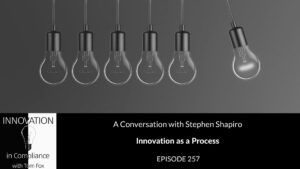Welcome to another episode of The Corruption Files!
Tom Fox and Michael DeBernardis explore their biggest takeaways from the appeal of the conviction of former Terra Telecommunications Corp. executive Joel Esquenazi. He and other involved parties were proven to pay bribes to Haitian government officials in a grand scheme. The case remains an example of a significant conclusion from a defense involving the FCPA.
 The Instrumentality Ruling of United States v. Esquenazi with Tom Fox and Michael DeBernardis
The Instrumentality Ruling of United States v. Esquenazi with Tom Fox and Michael DeBernardis
Key points discussed in the episode:
 The Esquenazi decision is vital in providing clear guidance for businesses to design robust compliance programs to address corruption, avoid making grease payments to foreign government officials, and remove the temptation to cull business favors and advantages for their company.
The Esquenazi decision is vital in providing clear guidance for businesses to design robust compliance programs to address corruption, avoid making grease payments to foreign government officials, and remove the temptation to cull business favors and advantages for their company.
 Companies doing business abroad should never forget the learnings from the Esquenazi decision in 2014. Following the conclusion of the Court of Appeals was identifying ownership and financial control to decipher the “instrumentalities” of foreign governments and to correctly identify that there were no red flags for FCPA compliance.
Companies doing business abroad should never forget the learnings from the Esquenazi decision in 2014. Following the conclusion of the Court of Appeals was identifying ownership and financial control to decipher the “instrumentalities” of foreign governments and to correctly identify that there were no red flags for FCPA compliance.
 The 11th Circuit Court of Appeals’ opinion clarifies how a two-part test is crucial in determining the “instrumentality” of an employee, officer, agency, or department as an entity of foreign governments. The elements of “control” and “function” served as the two prongs that the US Court of Appeals for the Eleventh Circuit made in its decision for Esquenazi and the others involved in the case.
The 11th Circuit Court of Appeals’ opinion clarifies how a two-part test is crucial in determining the “instrumentality” of an employee, officer, agency, or department as an entity of foreign governments. The elements of “control” and “function” served as the two prongs that the US Court of Appeals for the Eleventh Circuit made in its decision for Esquenazi and the others involved in the case.
 A key indicia of a governmental entity is it doesn’t have to make a profit. Think about the United States Postal Service — today; it still stands as a government service. Everyone uses it — and we don’t want it to go away even if it doesn’t make a profit. Indeed, non-earning can be the biggest indicator if you assess what constitutes any employee, officer, agency, or department as an “instrumentality” of foreign governments where clients are conducting business.
A key indicia of a governmental entity is it doesn’t have to make a profit. Think about the United States Postal Service — today; it still stands as a government service. Everyone uses it — and we don’t want it to go away even if it doesn’t make a profit. Indeed, non-earning can be the biggest indicator if you assess what constitutes any employee, officer, agency, or department as an “instrumentality” of foreign governments where clients are conducting business.
 United States v. Esquenazi is a well-settled FCPA case that didn’t go to the U.S. Supreme Court. The Esquenazi decision is a significant case law that came out of a defense trial with the defendant paying heavily and sentenced to prison for 15 years — a landmark decision that remains relevant today.
United States v. Esquenazi is a well-settled FCPA case that didn’t go to the U.S. Supreme Court. The Esquenazi decision is a significant case law that came out of a defense trial with the defendant paying heavily and sentenced to prison for 15 years — a landmark decision that remains relevant today.
 Key lessons learned from United States v. Esquenazi:
Key lessons learned from United States v. Esquenazi:
1. Ownership/Financial Control – There is no percentage amount listed, but the inclusion of financial control would indicate that anything over 50% would be a significant factor.
2. Actual control is key in all three court decisions. In Lindsey and Esquenazi, it is characterized as the government’s right to appoint key officers and directors. In Carson, it is called government control. But this means that if the government exercises actual control, it may trump the 50% guidance stated above.
3. Privileges and Obligations are also mentioned in all three. Does the entity have the right to control its functions?
4. Financing – Is the entity a for-profit entity financed through its revenues, or does it depend on financing by its government?
5. Perception is Reality – André Agassi’s immortal words appear again. If it is widely perceived as providing an official function, it is an instrumentality under the FCPA.
—————————————————————————-
Do you have a podcast (or do you want to)? Join the only network dedicated to compliance, risk management, and business ethics, the Compliance Podcast Network. For more information, contact Tom Fox at tfox@tfoxlaw.com.


 The Instrumentality Ruling of United States v. Esquenazi with Tom Fox and Michael DeBernardis
The Instrumentality Ruling of United States v. Esquenazi with Tom Fox and Michael DeBernardis The Esquenazi decision is vital in providing clear guidance for businesses to design robust compliance programs to address corruption, avoid making grease payments to foreign government officials, and remove the temptation to cull business favors and advantages for their company.
The Esquenazi decision is vital in providing clear guidance for businesses to design robust compliance programs to address corruption, avoid making grease payments to foreign government officials, and remove the temptation to cull business favors and advantages for their company.
